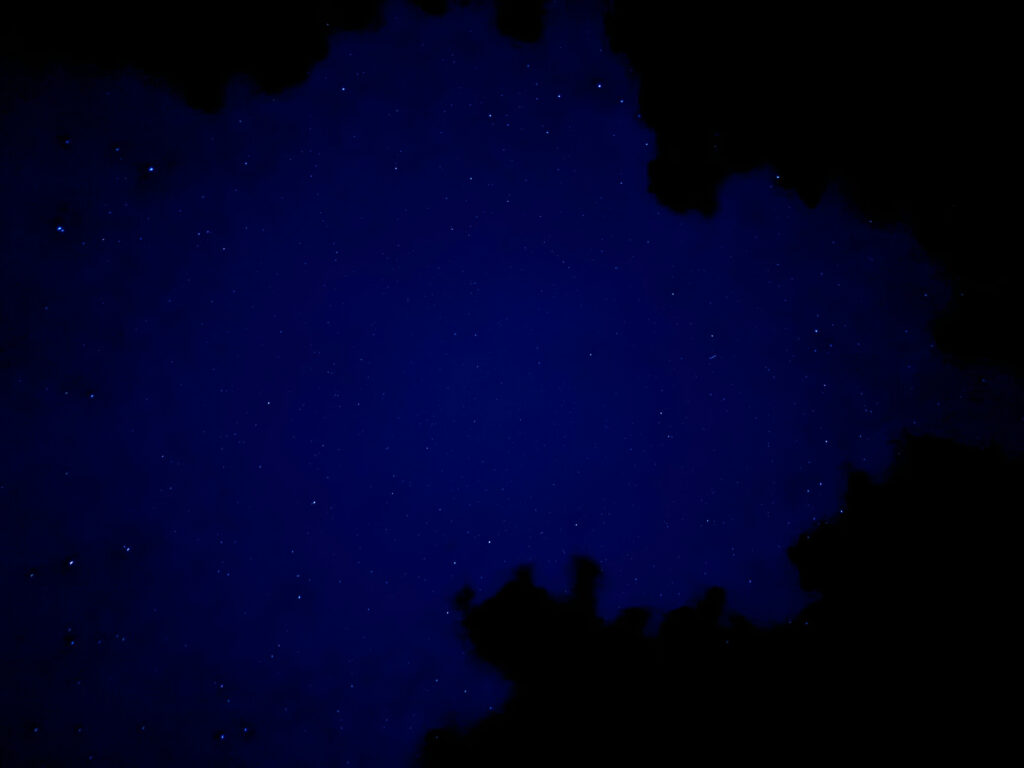
The sky was dark and smattered with stars. The Big Dipper shone out, bright and prominent. I stood on the campground road, looking up, my mouth partly open as if I was about to say something but then stopped in surprise. I watched the sky for a few minutes and then walked up the road to our campsite, my flashlight off. I gazed upwards every few moments, trying to cement the sight into my memory.
As I reached the campsite, my kids were getting ready to walk to the bathroom. “Keep your flashlight off!” I recommended. “You’ll see the stars so much better.” They hesitated, then turned them off, trusting me and the desire to see that beauty themselves.
It would be easy for me to be scared in that moment. Large, dark spaces freak me out and the scariest night of my life was alone in a dark campground. (It turned out okay, but it was a legitimately terrifying situation.) I could have walked my kids to the bathroom instead of trusting them to be safe.
But I wasn’t. I was too overwhelmed by wonder at the stars. Awe crowded out fear, not even giving it a foothold. This was too important to be scared.
As a person with anxiety, it’s easy for me to be scared of things. In fact, much of the time that anxiety doesn’t show up as conscious thoughts, but as an underlying jitteriness and inability to rest. So I can’t even talk back to those anxious thoughts with logic.
But one of the key things that relieves it is immersing myself in nature. Not only does the beauty overwhelm any specific sense of fear of what’s around me, but the anxiety I carry around all the time.
Of course, it’s easy to immerse yourself in the natural, not human-built world when you’re camping.
But even when I’m at home, I can find refuge in walks around my neighborhood. I try to quiet my mind and open my senses to just take in what’s around me, from the feeling of the wind on my skin to the bright colors of the neighbor’s flowers to the birdsong. My eyes soften, my breathing slows, and my shoulders drop. I’ve heard people compare it to the grounding exercise to name 5 things you see, 4 things that you hear, 3 things that you feel, 2 things that you smell, and 1 thing that you taste. But for me, it’s far more meditative than that. It’s less about grounding myself in things that are concrete and more about losing myself in the patterns and beauty of nature and my bodily experience of them.
Often, this conscious effort to look, listen, and feel allows me to find small beauties that I would have missed otherwise, whether it’s the interplay of light in tree leaves or reflections of the sky in puddles.
I’m working to pass these lessons and skills on to my children. I’ve pointed out small moments of beauty since they were little and they’ve always reciprocated. I still try to take the time to stop and look at every cool mushroom and insect. My older son has gotten very into trying to identify various plants, fungi, and animals. I also specifically explain to them the role my walks play in my mental health and have described my meditative exercise. At the same time, I tell them that what works for me may not for them – but that I’ll help them figure out what will work for them. In some cases, it may not be nature at all.
It’s impossible to avoid fear and anxiety. Our world has far too many problems to be legitimately fearful and anxious about. At the same time, you can’t live in that space all the time – it’s exhausting and breeds apathy rather than action. Finding solace in wonder and awe – whether in the natural world or another area – can help us find the balance that allows us to embrace joy despite the challenges around us.
How do you and your family embrace wonder?
I love how this made me see things from a different perspective. You’ve really captured something special!